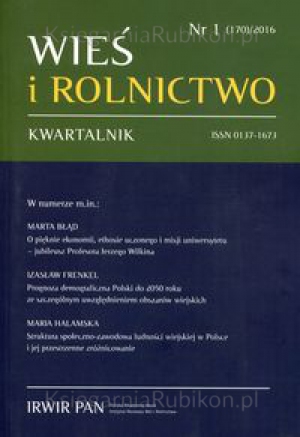Modele gospodarstw rolnych w państwach Unii Europejskiej
Models of farms in the European Union
Author(s): Arkadiusz Sadowski, Walenty Poczta, Ewelina Szuba-Barańska, Patrycja BebaSubject(s): Economy
Published by: Instytut Rozwoju Wsi i Rolnictwa Polskiej Akademii Nauk
Keywords: agriculture; models of farms; the European Union; rolnictwo; modele gospodarstw rolnych; Unia Europejska
Summary/Abstract: This article presents an examination of results of a study, together with the original methodology used, on the level and balance of social capital in the rural areas of Pomerania, and how this can be related to the development potential of local communities. The results of studies in nineteen rural communities in Pomerania clearly indicated that levels of capital for development were not the main reason for poor development, but rather the a negative balance between various individual elements that, together, comprise social capital.Local inhabitants who were surveyed associate their ability to act with the lack of informal relationships with Public Sector and not locally based Non Governmental Organisations.The tendency observed has been for widespread appearance of ineffective and socially poorly viable communities, which, when there are initiatives and the availability of external development funds have little chance to implement projects or achieve results.Further it is the balance of social resources and poor institutional development which limits the potential for external involvement in the investigated communities. This drastically reduces the institutional capacity of communities and decreases the density of networks and relationships that links the community with managing its own development. The study showed that rural inhabitants in Pomerania do bestow trust in local self government, however relatively few participate in its work.Various variables were tested and of these research revealed a strong correlation between economic situation and balance of social capital of the respondent these, however did not correspond with predictions formed on the basis of a strong local identity and the dynamics of the community as a whole.W artykule scharakteryzowano i określono znaczenie poszczególnych modeli gospodarstw rolnych, wyodrębnionych na podstawie badań własnych jako rodzinne, drobne i wielkotowarowe. Delimitacji dokonano na podstawie struktury siły roboczej oraz relacji dochodu rolniczego do płacy minimalnej. Za podmioty rodzinne przyjęto te, w których dominuje praca własna rodziny rolniczej, a dochód w przeliczeniu na jedną osobę pracy własnej przewyższa płacę minimalną netto w danym kraju. Jednostki charakteryzujące się przewagą pracy najemnej nad pracą własną uznano za gospodarstwa wielkotowarowe. Pozostałe gospodarstwa, gdzie dochód uzyskiwany przez osobę pełnozatrudnioną był niższy od płacy minimalnej, zostały sklasyfikowane jako drobne.Na podstawie przeprowadzonych badań stwierdzono, że dominującą formą gospodarowania na obszarze Unii Europejskiej jest rolnictwo rodzinne, które w przeważającej części państw UE angażuje największą część zasobów. Występuje jednak grupa krajów, w których istotną rolę odgrywają podmioty wielkotowarowe ze względu na duży udział w uzyskiwanej produkcji rolnej i angażowaniu zasobów ziemi i pracy. Gospodarstwa drobne, mimo że w wielu krajach przeważają liczebnie, to jednak mają niewielkie znaczenie ekonomiczne, ze względu na nieznaczny udział w zasobach ziemi i przede wszystkim małą partycypację w wytwarzaniu krajowej produkcji rolnej.
Journal: Wieś i Rolnictwo
- Issue Year: 168/2015
- Issue No: 3
- Page Range: 43-62
- Page Count: 20
- Language: Polish

